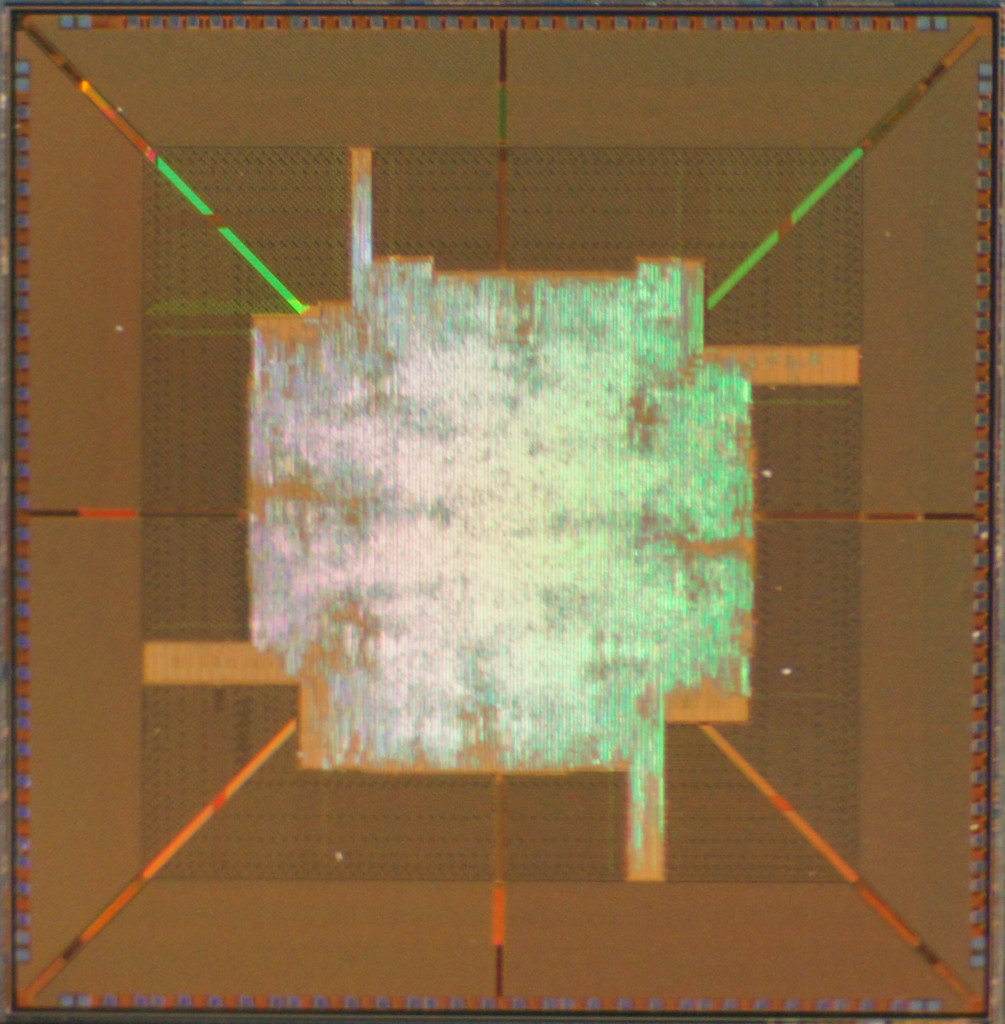Propeller 2 die picture
 David Carrier
Posts: 294
David Carrier
Posts: 294
I have attached a picture of a Propeller 2 die. It is a little blurry, because I didn't have the camera's microscope adapter with me, so I ended up hand-holding it over the microscope. Fortunately the camera has image stabilization built into the body, since I wasn't using a lens.
David Carrier
David Carrier



Comments
Cool!Cool!
Are some supplied packaged, and some as bare-die ?
The refraction on those orthogonal lines looks neat though!
How difficult would that be to do?
What's on top is the metal 6, or top metal, layer. There is glass over it, except where the pad openings are. There are 5 layers of metal under metal 6, then poly, then diffusion. You are seeing metal 6, mainly, in the picture.
You can make out 8 clouds of metal 6 noise, arranged like pie slices in the center area. Those are the 8 cogs.
I look at this and think, "What could possibly go wrong?"
I agree, for Propeller 1 too!
I have an 800x USB microscope I can bring tomorrow, and maybe get some clearer pictures.
Attached is an example of a UVEPROM I took with the same camera.
(to compare with propeller 1: 350nm, 7.28mm x 7.28, 53 sq mm)
exactly...
I look at this and think, "Look... it's green!!!"
Watching Beau's presentation he was showing the design, in what ever tool that was, zooming in from the entire chip down to almost individual transistors. Panning around here and there and pulling up different layers.
It occurs to me that a big color poster made from that actual design would be very nice.
Just give the design tool to some suitably artistic type who can find a nice scale and color scheme.
I mean, the shots shown here:
http://forums.parallax.com/showthread.php/147806-Prop2-arrives-today-but-it-won-t-work?p=1182316&viewfull=1#post1182316
are kind of fascinating.
@Ramon - The die measures 7.68mm square
I like the fourth photo, because it looks a bit like a tilt-shift small world photo. The structure looks like some kind of elaborate high tech prison designed to keep that dark maelstrom of cog logic securely held.
I also like the third photo because the blue pin pads look very much alive
Beau's second picture, first post (226-2.jpeg)... looks like the P2 is reclining on a gold coin... Spanish? Piece of eight from the Otocha?
Rich
Hm... lots of .jpeg smearing. Is that the forum software or the microscope? If you have a digital camera with a long zoom lens, a strong hand magnifying glass is enough to do some nifty macro work. I've been able to get a whole almond to fill the picture frame that way. It's such a pretty die, I want to see more detail!
Lawson
P.S. whoever mentioned making the layout view a poster has an awesome idea. Some re-colored layouts from a side project of mine.
@localroger - The automated spaghetti routing is a result of precise timing that would otherwise be incredibly difficult or near impossible to do by hand. If you can visualize the Propeller I with COGS on top and communication buss on the bottom. Take the East and West most ends and wrap them together so that it forms a circle (COG0 would abut COG7) with the communication buss now located in the center. That essentially is how the auto-router placed the design together, resulting in the 8 'lobes' you see representing each cog. Using a central communication buss between COGS was essential in meeting communication timing requirements.
I like the idea of a poster ... let's get the P2 corrected and worry about that stuff at a later time.
Edited to add: in case the intent of this was misunderstood, even with an unpowered die you would see structures. From wikipedia - "Silicon is transparent to infrared light with wavelengths above about 1.1 micrometres." Not as pretty as some pics, but it's an easy thing to do. I went through this with both powered and unpowered chips (WLBGA package) at EAG when we had a static RAM going into a high-power state.